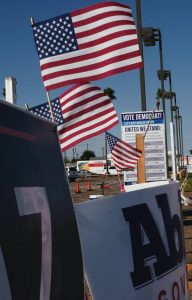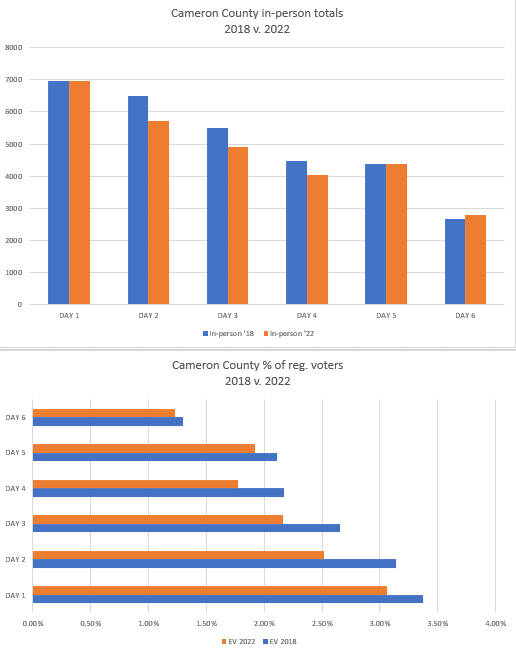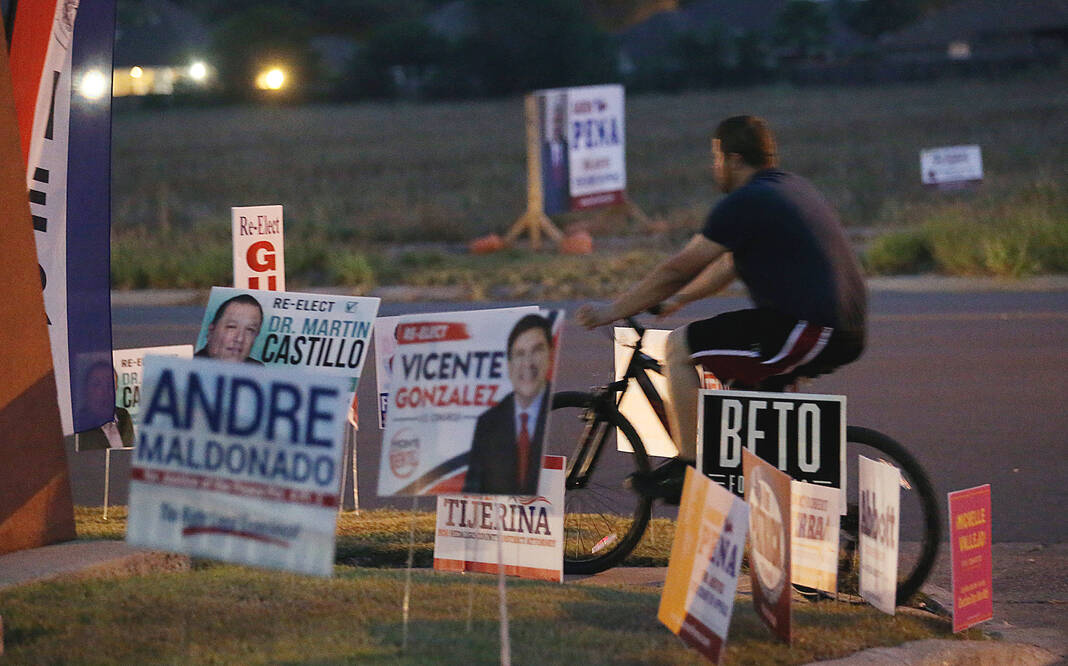
Voter turnout upset and underwhelmed expectations across Texas during the first week of early voting, including in the Rio Grande Valley, where levels failed to reach those of the last midterm elections.
Experts were puzzled by the outcome but suspected some key state and federal changes are adversely affecting participation at the polls.
“About two months ago, I was talking to some pollsters and I said, you know, I’m thinking of projecting the turnouts, kind of the average of 2018 and 2020 [elections],” Derek Ryan, a Republican data analyst, said Friday. He projected the 2022 turnout would be somewhere between the average turnout of the last two elections.
Ryan’s friends agreed; many across Texas held similar assumptions.
“I would think that these three, otherwise, kind of close to competitive elections — which are actually pretty rare in the U.S. House of Representatives — usually coincides with an elevated level of turnout,” Alvaro Corral, an assistant professor at UTRGV’s political science department, said Friday, referring to the Congressional District 15, 28 and 34 races from Laredo to Brownsville.
But so far, expectations fell short.


Fewer voters turned out in the first week of early voting throughout Hidalgo and Cameron counties than in the last midterms in 2018.
So far, about 12.4% of registered voters have voted in-person during the first six days of the election. By this time in 2018, the number was at 17.7%. In total, 52,013 people have shown up to vote in-person this year, but by the same time in 2018 about 64,319 had gone to the polls.
In Cameron County, 12.6% of registered voters have cast their ballot in-person during the first six days compared to 14.7% in 2018. The total number of early voters this year as of Saturday was 28,844, compared to 2018 when 30,491 had gone out to vote in person.
Starr and Willacy counties did not have historical data available on their websites to provide a comparison for 2022 election turnout.
Low voter turnout has been observed throughout Texas. Almost 20.5% had already voted by this time in 2018 compared to the 12.8% of Texans who have voted this year.
Hidalgo and Cameron counties, however, fall below the state average of registered voters who already cast their ballots.
Tarrant, Harris, and El Paso counties, which are as great or greater in population as Hidalgo and Cameron counties, also experienced a decrease in their turnout.
On Friday afternoon, one of the busiest election sites, the Hidalgo County Election Annex in Edinburg, was full of empty parking spaces and short lines.
In some parts of the state, the weather was to blame for keeping voters away, but the day carried a cool breeze and cloudy skies.
“I came today because it’s my day off from work,” Samuel Garcia, 24, said Friday. “I’ve never actually voted on Election Day. I usually try to come to early voting.”
Busy professionals like Otilia Pruneda, 45, a special education teacher, needed to wait for the weekend to make time, but all said one main race drew them out.
“Everybody’s fed up with Greg Abbott,” Pruneda said. “It’s a lot of things going on with the teachers. I mean, there’s a lot of work, there’s not enough pay, and they expect for us to do more than we can do on a daily basis.”
Two young women, both 18 years old, were prompted to vote for the first time in their lives in the same race.
“I think governor probably was just the main one that I was really focused on,” Sofia Chavez, 18, said. “I really decided on where I stood with my point of views on gun control, so I pretty much knew who I was going to vote for. I voted for Beto.”
Barrera, her friend, said gun control was on her mind when heading to the polls.
Garcia, who described himself as Republican, also went with a similar purpose in mind but took a different stance.
“I do own just like a handgun. But I do plan on buying more guns in the future, so that’s kind of important,” Garcia said. “Well, it’s Texas.”
For Garcia, the choice wasn’t clear-cut.
“I voted for Greg Abbott. I did mull the decision for a little bit. Personally, I’m not a huge fan of Abbott’s, but it was the easy decision for me,” Garcia said.
Only Ruiz, the school teacher, seemed to prioritize local races.
During midterm elections, local races are mostly decided during the primaries, leaving some local races decided and mostly state races on the ballot.
“They’re trying to explain to someone that the Railroad Commission and the comptroller are important to them,” Strother said, referring to candidates. “That’s a lot harder argument. And so people are naturally going to be more motivated to participate in elections that are deciding who represents them locally than they are the bigger elections like statewide where they’re not even sure who those people are or what their job is.”
In spite of the voters’ personal efforts, most of their families had yet to vote on Friday.
“You know, peer pressure is the most powerful influence in politics. It’s not money, it’s not incumbency, it’s not anything else. It’s peer pressure,” Colin Strother, a democratic strategist who recently worked on campaigns for U.S. Rep. Henry Cuellar and state senators Ryan Guillen and Joaquin Castro, said Friday. He believes Democrats will need to push hard to move the needle on turnout.
“We can either be nice for two weeks and lose. Or we can be rude for two weeks, and we can win,” he said.
Comparing the turnout to 2018, however, may be unfair, Dr. Alvaro Corral, who studies voter behavior, said.
“The 2018 election, the previous midterms, were kind of a bit of an outlier,” he said, noting the numbers were higher than typical midterm elections. Corral said the lower turnout this year indicates a “reversion to the mean,” a return to the average low turnout rates.
Even outside of the Valley, other democratic regions like El Paso and Harris counties are trending low, too. Corral believes the current low turnout and the high turnout of 2018 are both related to the party holding the presidential office.
“Well, in 2018 we had a Republican in the White House, and this is a majority Democrat area,” Corral explained. “Maybe we’re kind of seeing a little bit of an effect that like the out party, Democrats in 2018, were really motivated, like there was this kind of backlash against Donald Trump, right? It was the first time that voters had the opportunity to kind of say they were displeased with the direction of the country.”
However, Tarrant County also showed a decline in participation this year. Strother explained it could be a period of adjustment.
“Anytime you change things on voters, it can disrupt their normal turnout patterns,” Strother said.
One of the major changes came in the form of redistricting.
“A lot of voters are creatures of habit,” Ryan, the republican data analyst, said. “So, you know, if any of those things changed, you know, it’s possible that they may say, ‘Well, you know, let me hold off a few days and figure out where I should go vote.’”
Changes to mail-in ballots are also proving to discourage their use, experts said.
“Because of former President Trump’s extensive efforts to cause people to distrust the mail ballot process, it looks like there are fewer Republicans voting statewide than there were in 2018,” Strother said. Ryan, his republican counterpart, agreed, in part.
“I think that the average age of a Republican primary voter this year was 61 years old. The average age of a Democratic primary voter, I think, was 58 years old,” Ryan said. “So when you’ve got an electorate that much older … that is part of why Republicans have had an advantage in the past.”
Another week remains before early voting numbers become clear.
“We’re all just kind of scratching our heads and wondering if this is the way it’s going to be for the entirety,” Ryan, the republican analyst, added, “or if there’s some surge that’s going to happen between now and Election Day.”
Instead of a surge during the weekend, the numbers dipped in Hidalgo and Cameron counties.




